Coal and Coalbed Methane Co-Extraction Technology Based on the Ground Movement in the Yangquan Coalfield, China
Abstract
:1. Introduction
2. Gas Occurrence Characteristics in the Yangquan Coalfield
2.1. Coal Occurrence Characteristics
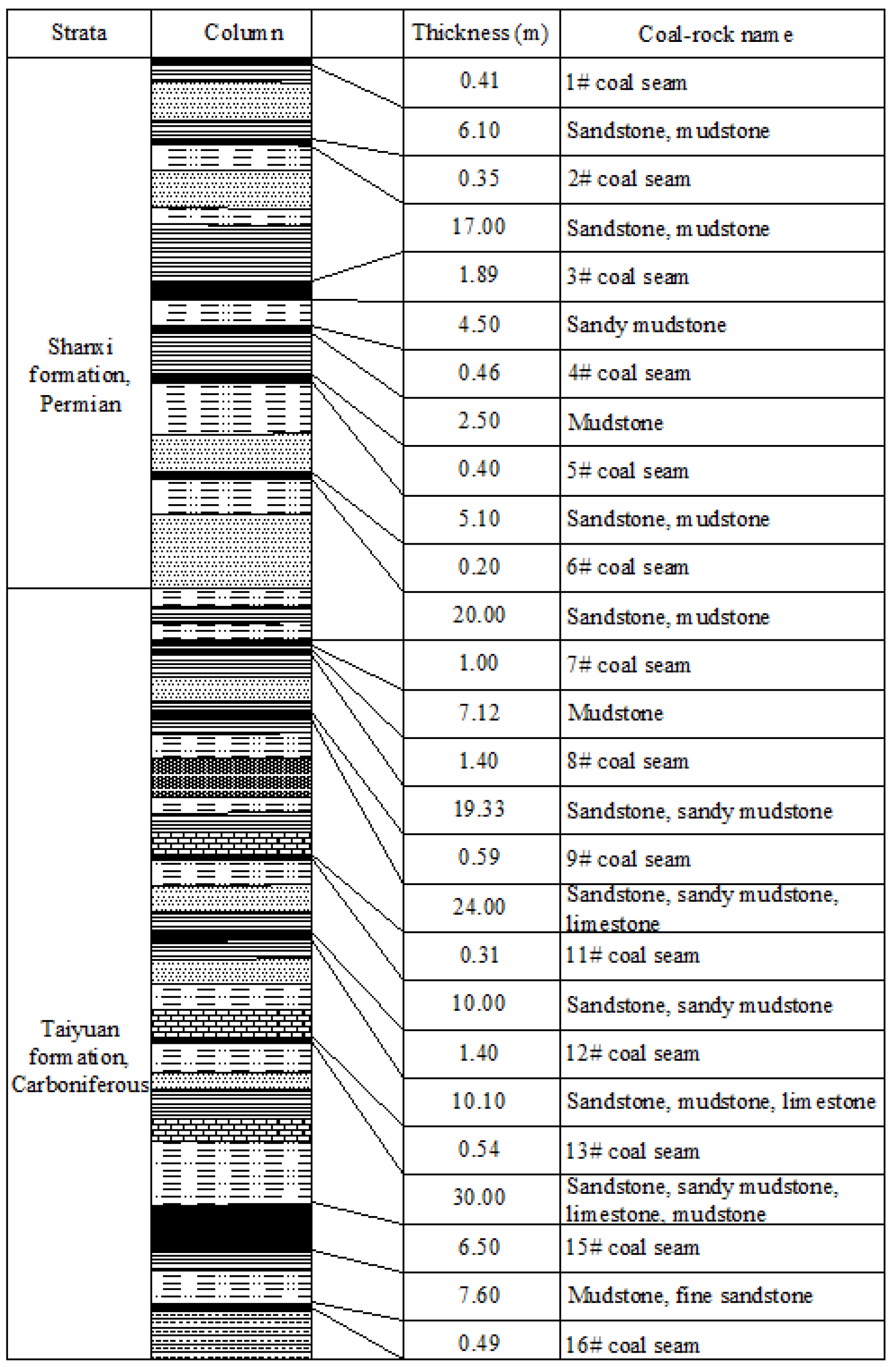
2.2. Coalbed Methane (CBM) Occurrence Characteristics
3. The Development of Coal and CBM Coextraction Technology Based on the Ground Movement in the Yangquan Coalfield
3.1. The Concept of Coal and CBM Co-Extraction

3.2. Principle of Coal and CBM Coextraction Based on the Ground Movement
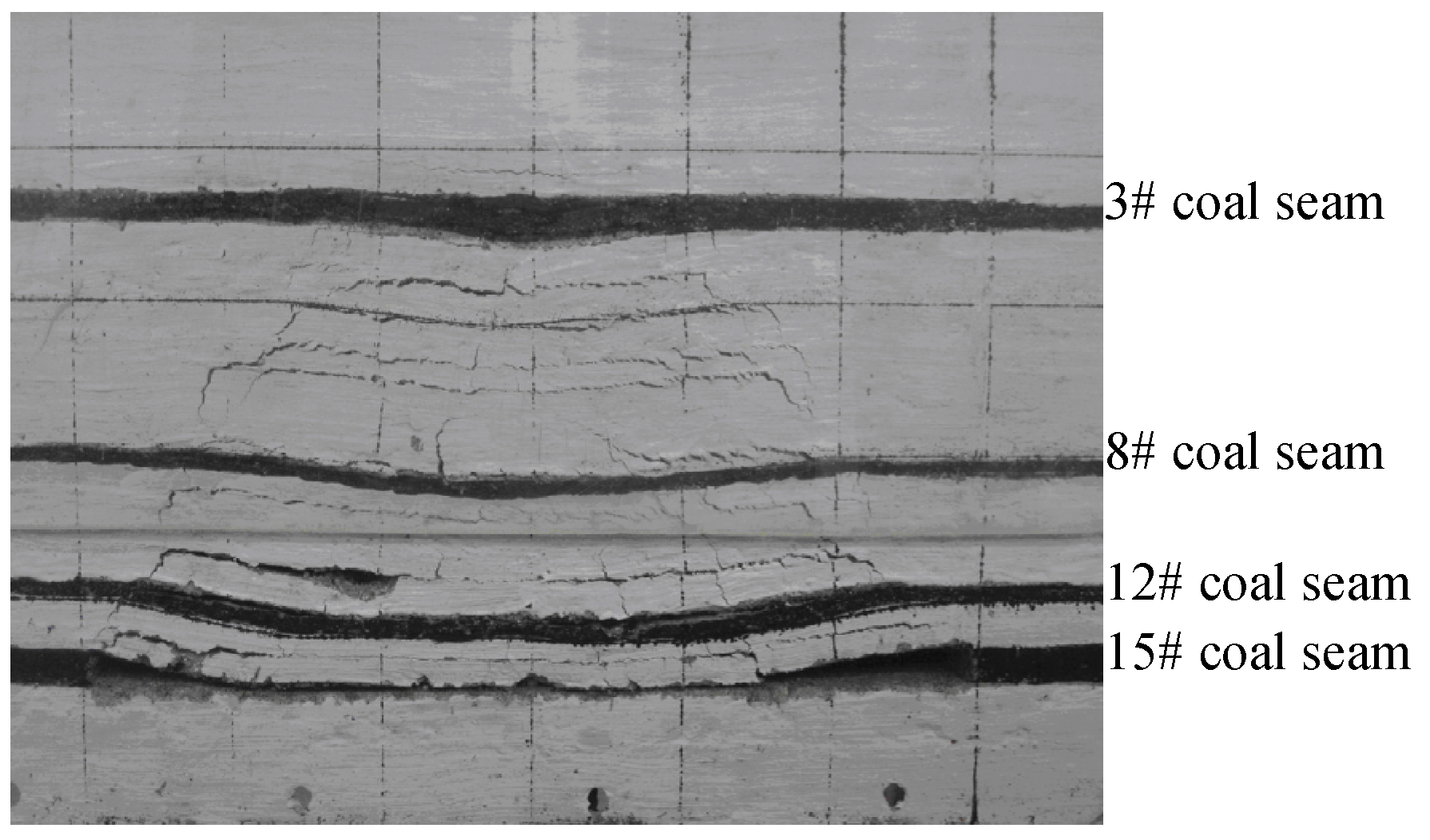
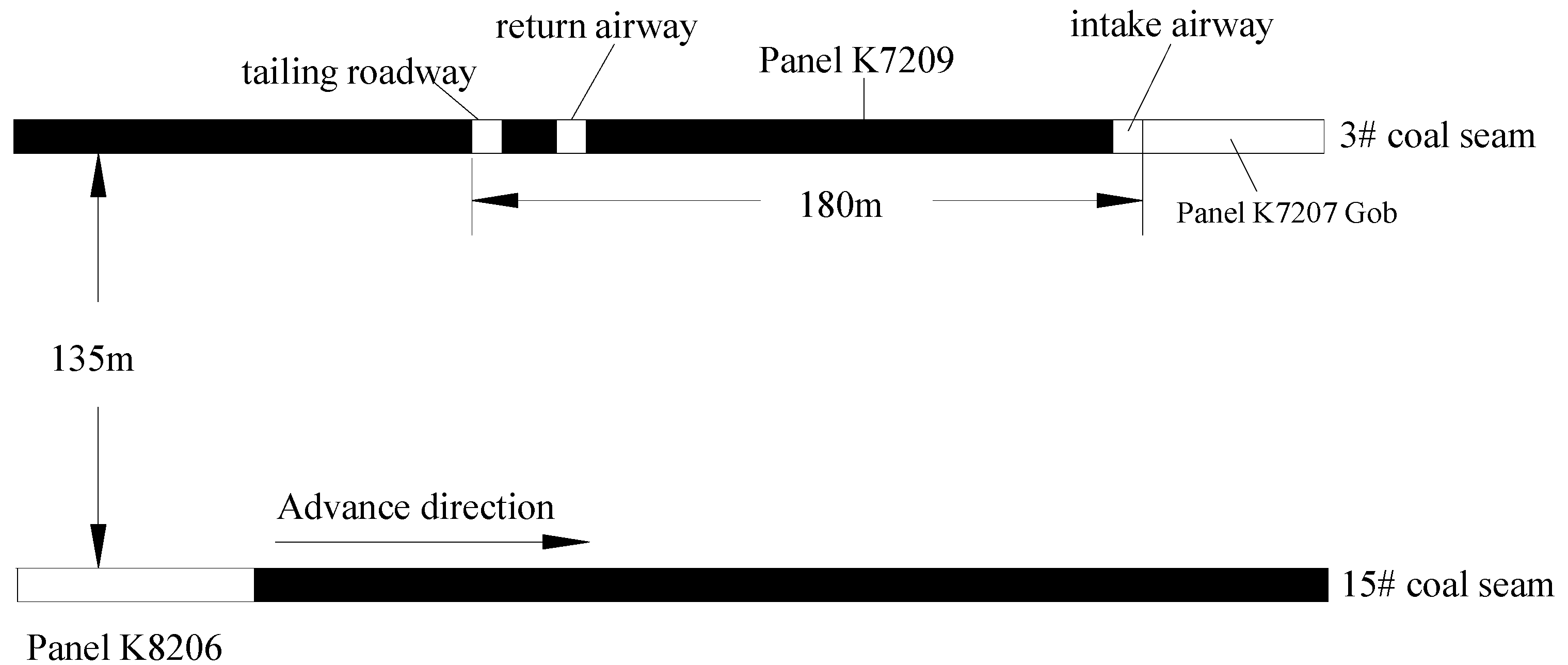
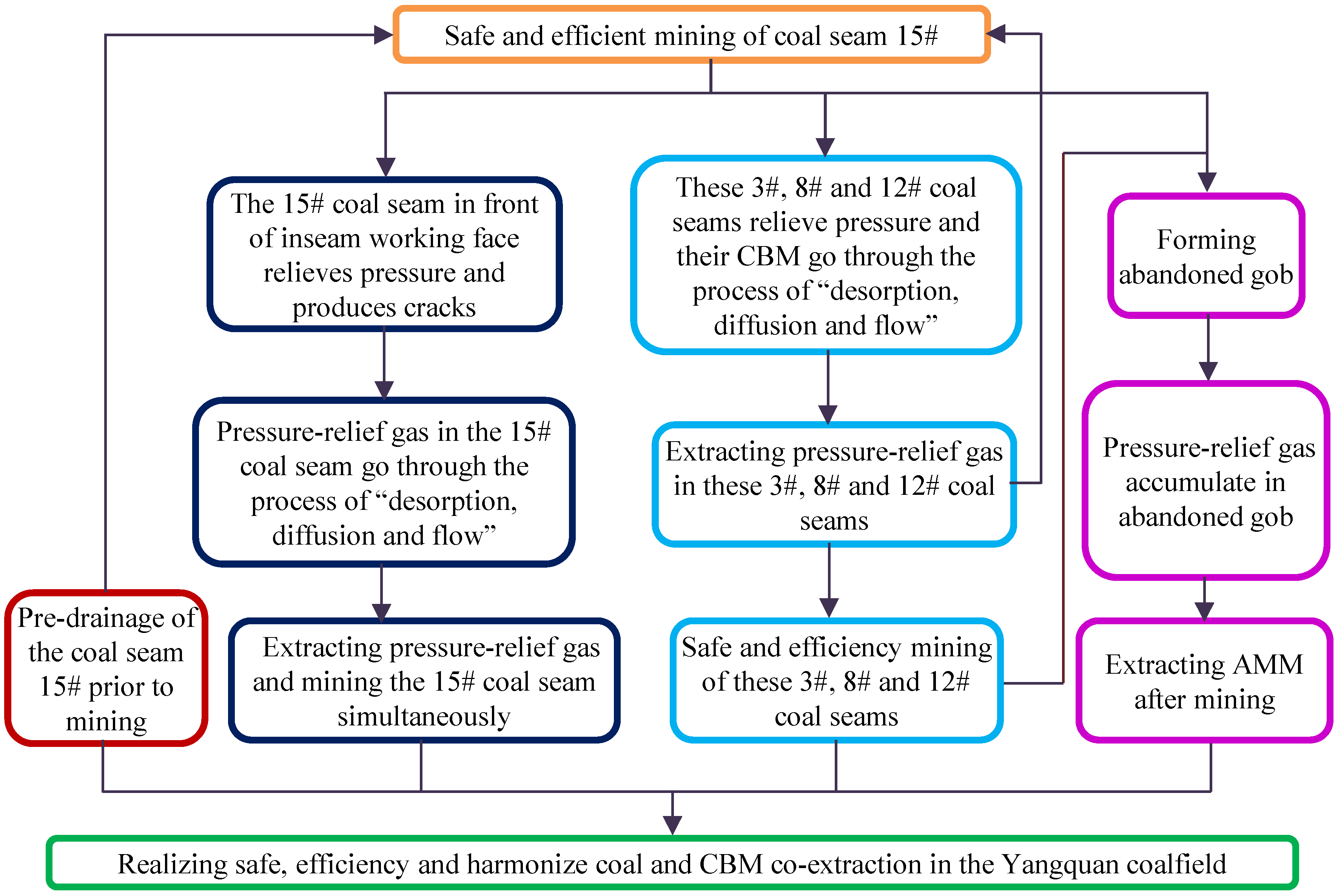
3.3. The System of Coal and CBM Co-Extraction Technology in the Yangquan Coalfield
- (1)
- The gas drainage prior to the coal mining, i.e., the predrainage of the CBM in the15# coal seam not only reduced the gas content and improved the mining safety, but also enhanced the mining efficiency of the 15# coal seam.
- (2)
- The coal and CBM coextraction, i.e., the pressure-relief gas of the 15# coal seam was effectively extracted by the “pressure-relief and permeability-increase effect” caused by the mining of the 15# coal seam. Simultaneously, based on the mining effect of the 15# coal seam on the gas pressure-relief law of the adjacent 3#, 8#, and 12# coal seams, the pressure-relief gas of the 3#, 8#, and 12# coal seams was effectively extracted by making full use of the favorable conditions of increasing the permeability of the coal seam.
- (3)
- The gas drainage after the coal mining, i.e., pressure-relief gas in the abandoned gob was extracted after the end of the mining of the working face, panel, or mine to make full use of the gaseous resources.
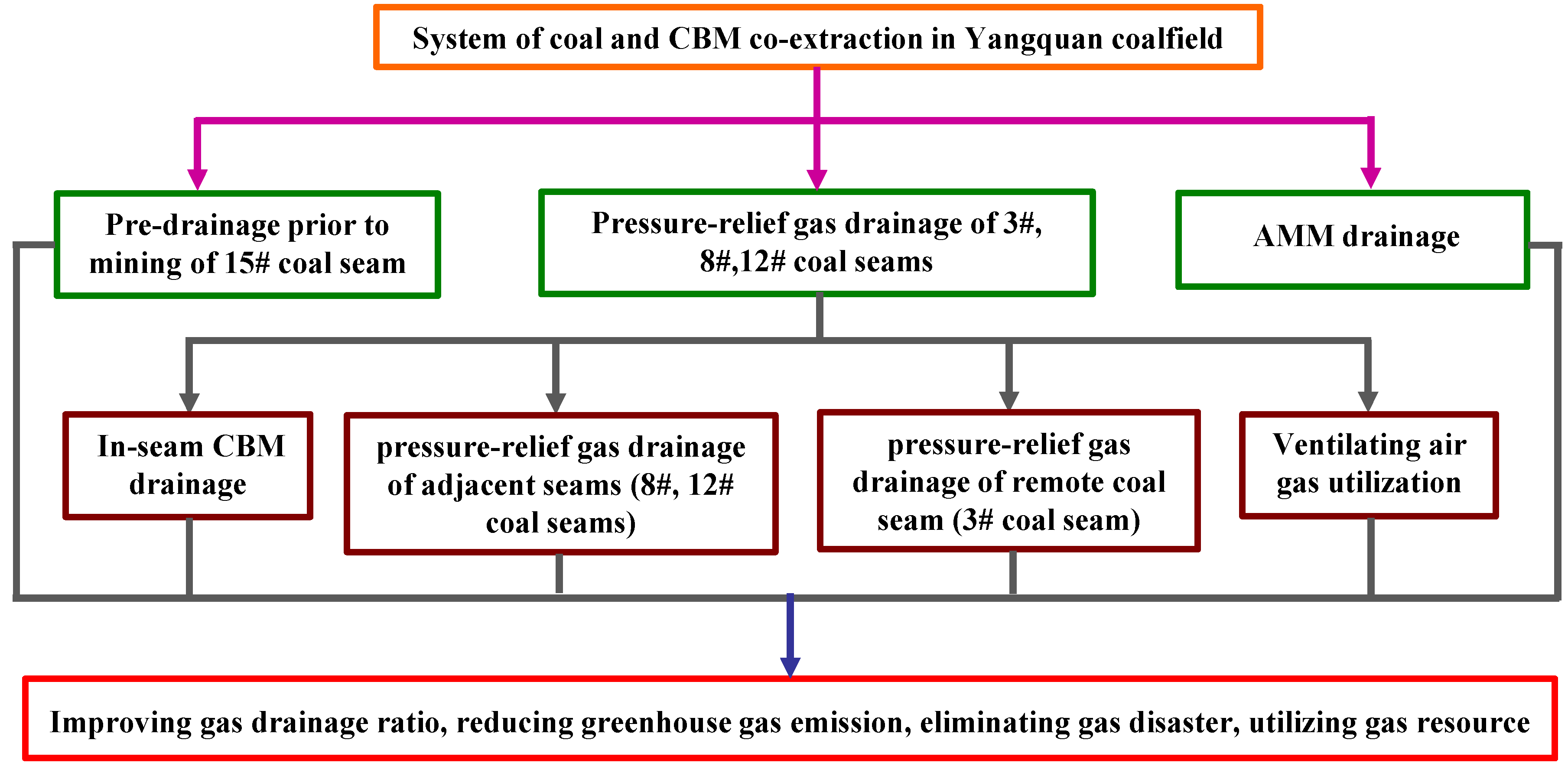
4. Coal and CBM Coextraction Technology Based on the Ground Movement in the Yangquan Coalfield
4.1. Technologies of Coal and CBM Coextraction for the Yangquan Coalfield

4.1.1. The Advance Pressure-Relief Gas Drainage Technology for Inseam
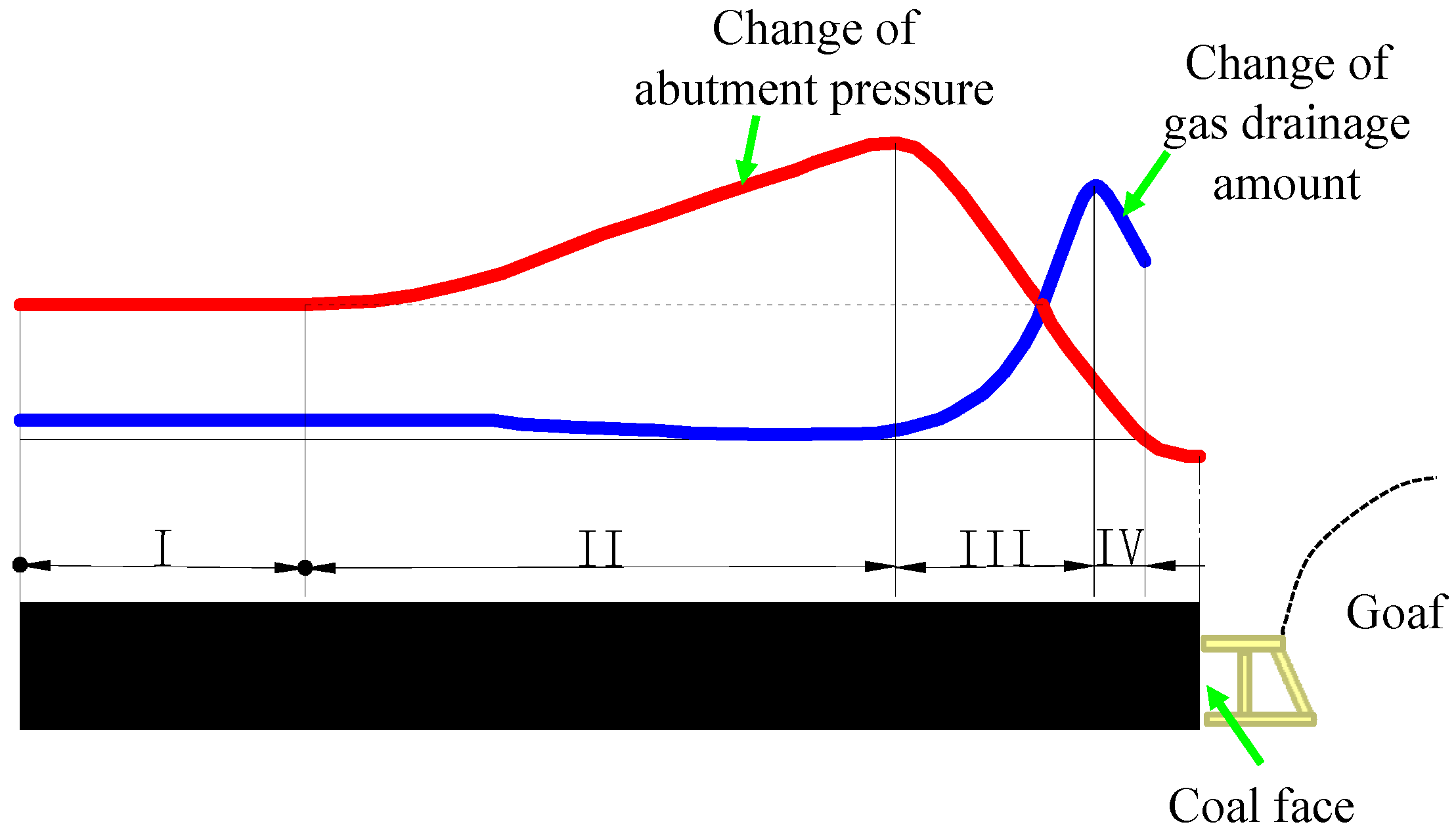
4.1.2. The Cross-Measure Borehole Gas Drainage Technology and the Gas drainage Technology of High-Level Gas Drainage Roadway Based on Key Strata Movement for Adjacent Seams
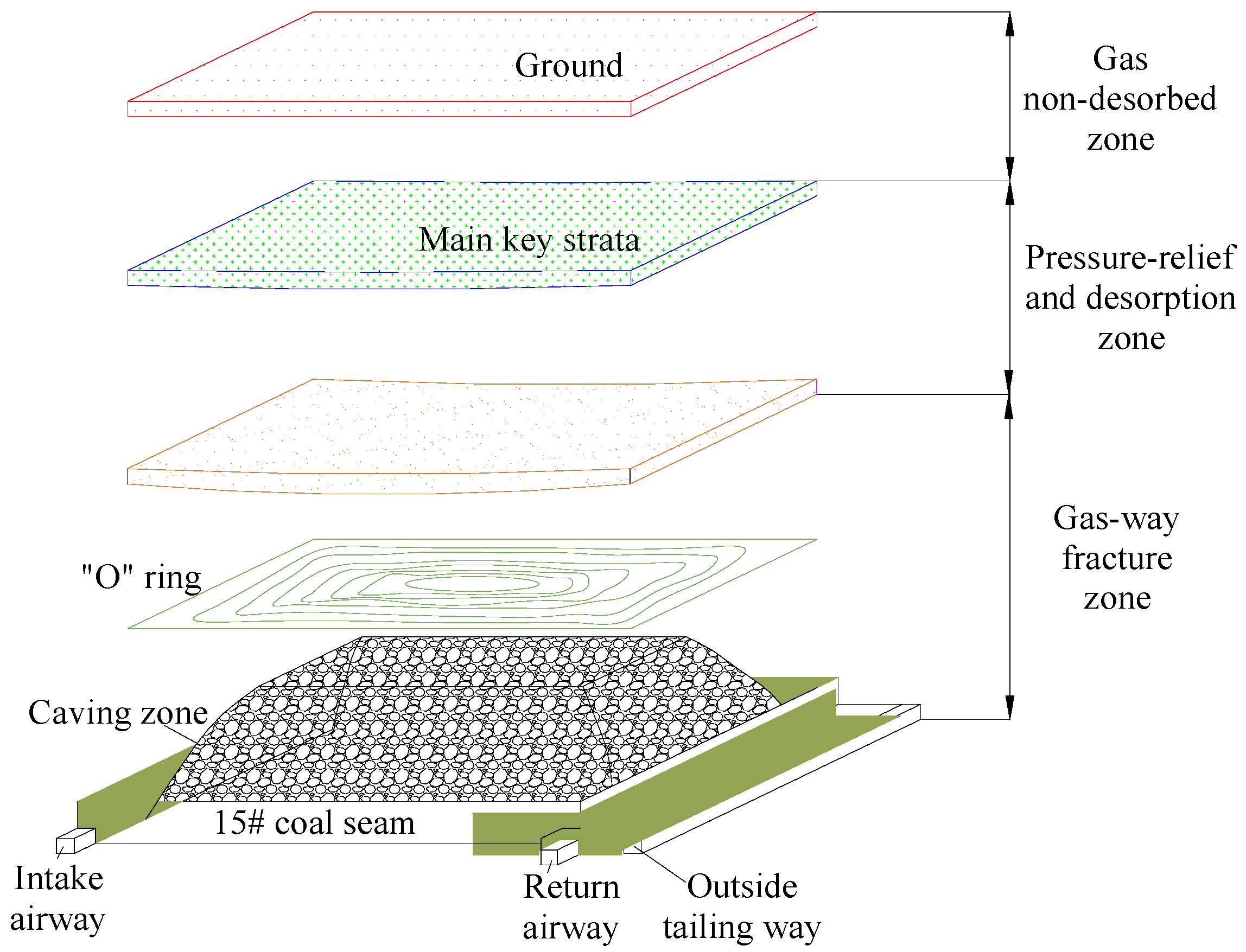
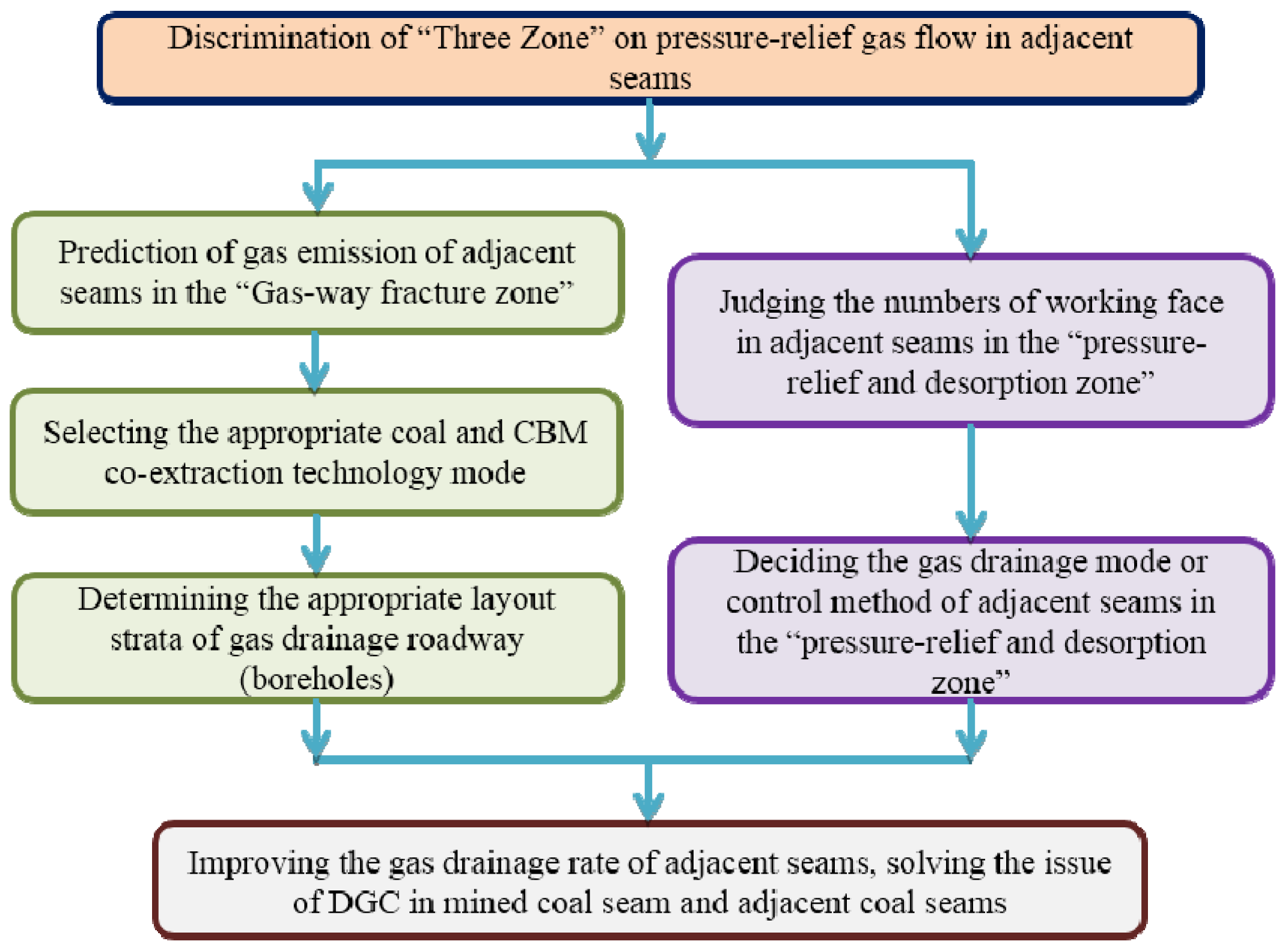

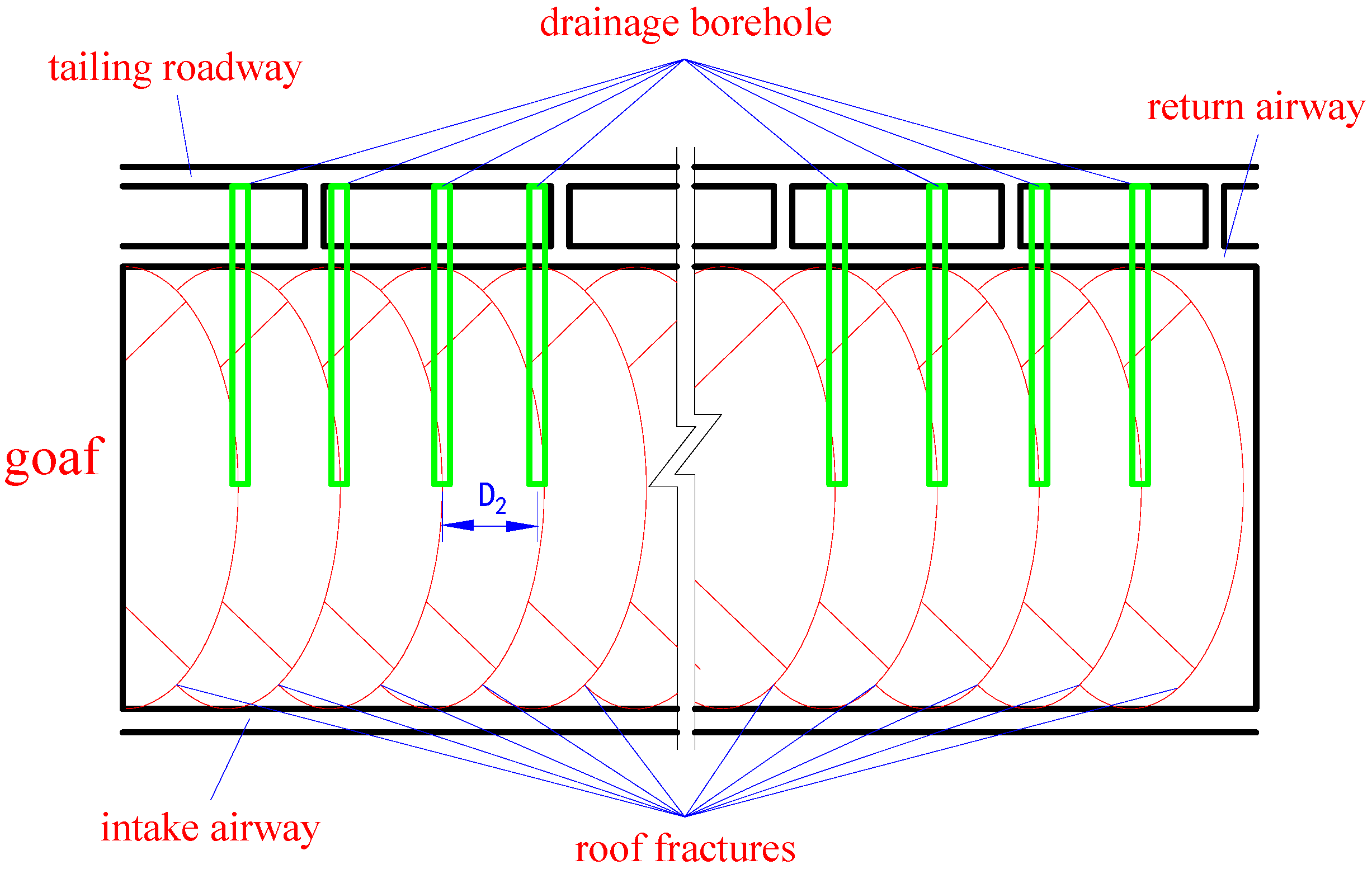

4.1.3. Abandoned Mine Methane (AMM) Drainage Technology
4.2. Implementation Results
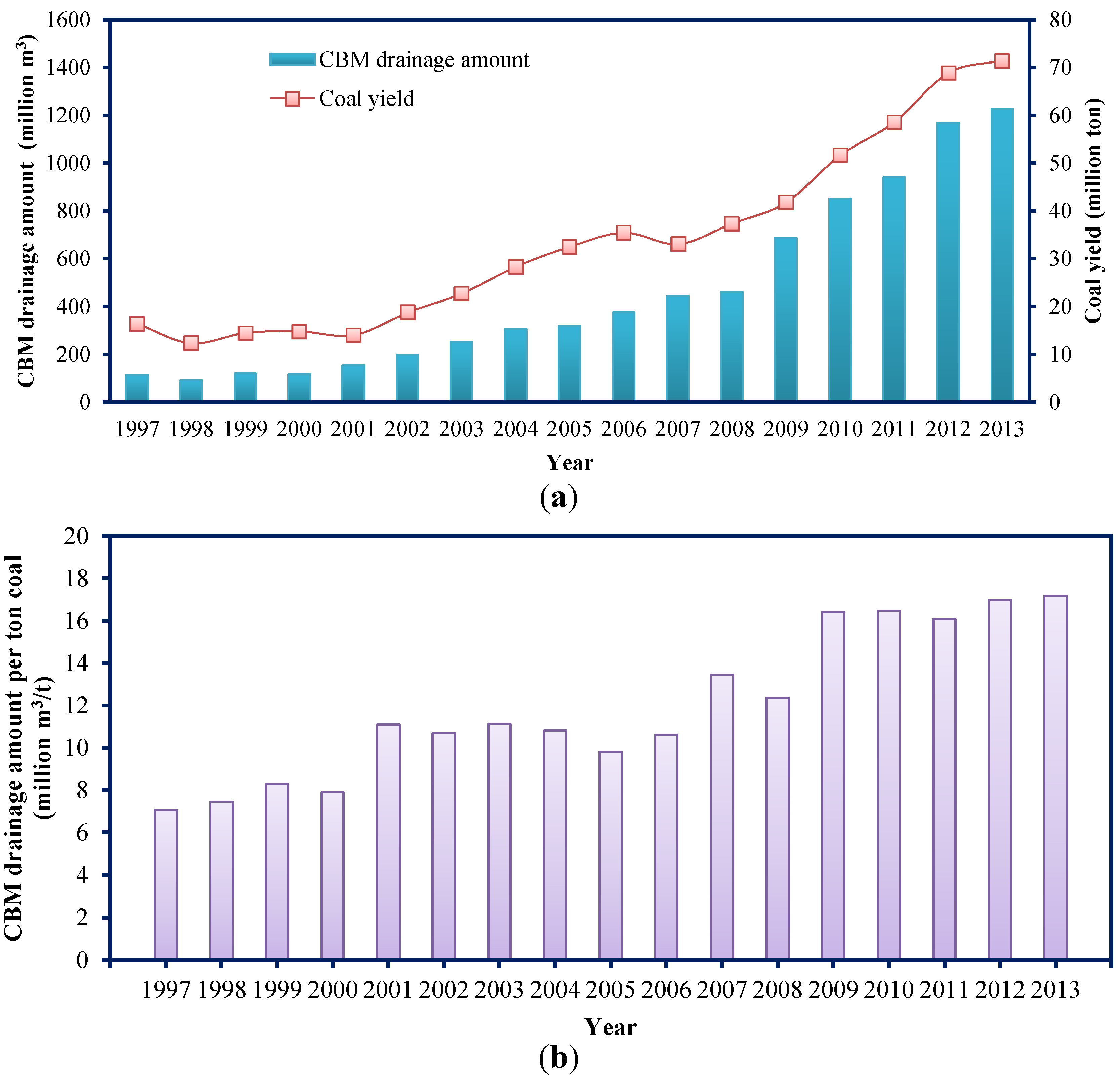
4.3. Analysis and Comparison of the Yangquan Coalfield and Other Typical Mining Areas in China
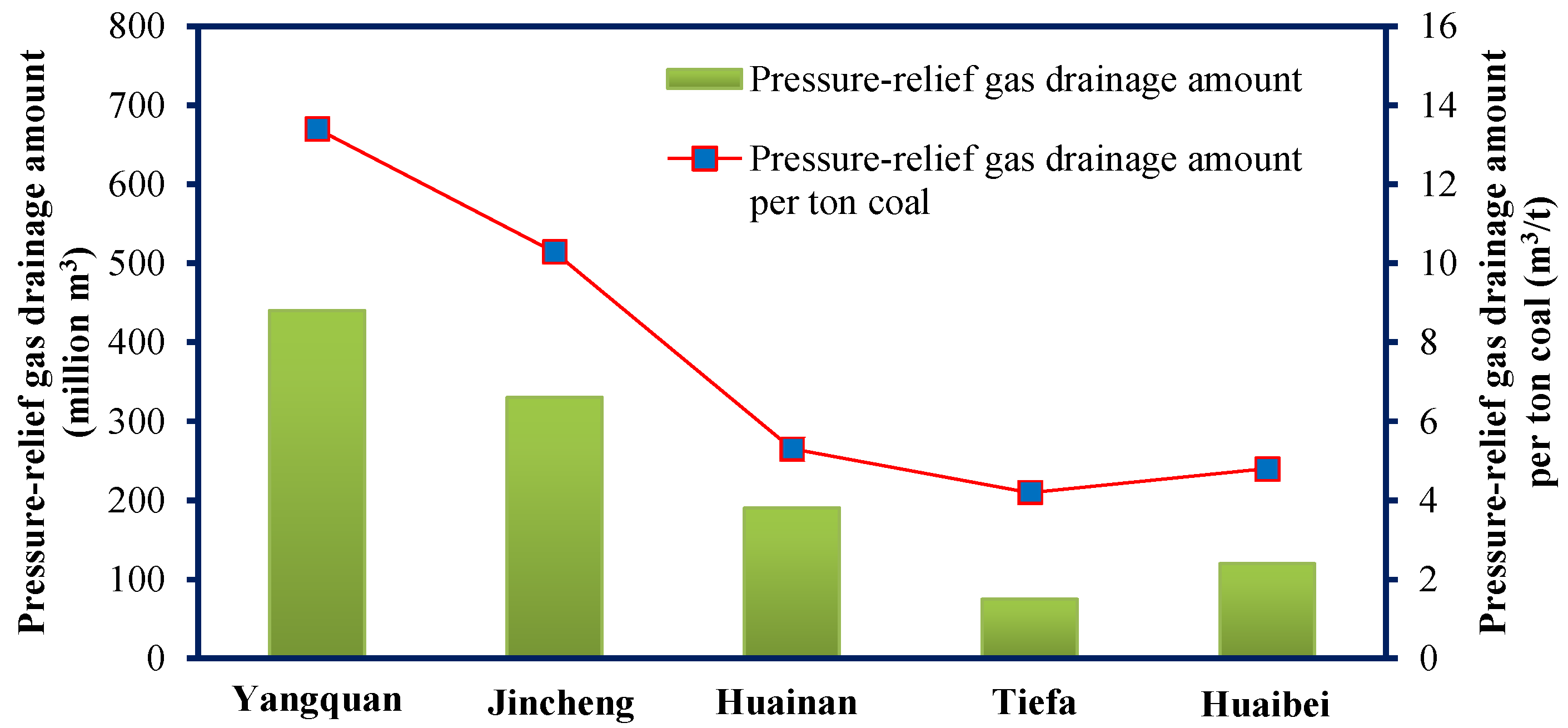
5. Comprehensive Gas Utilization Technology in the Yangquan Coalfield
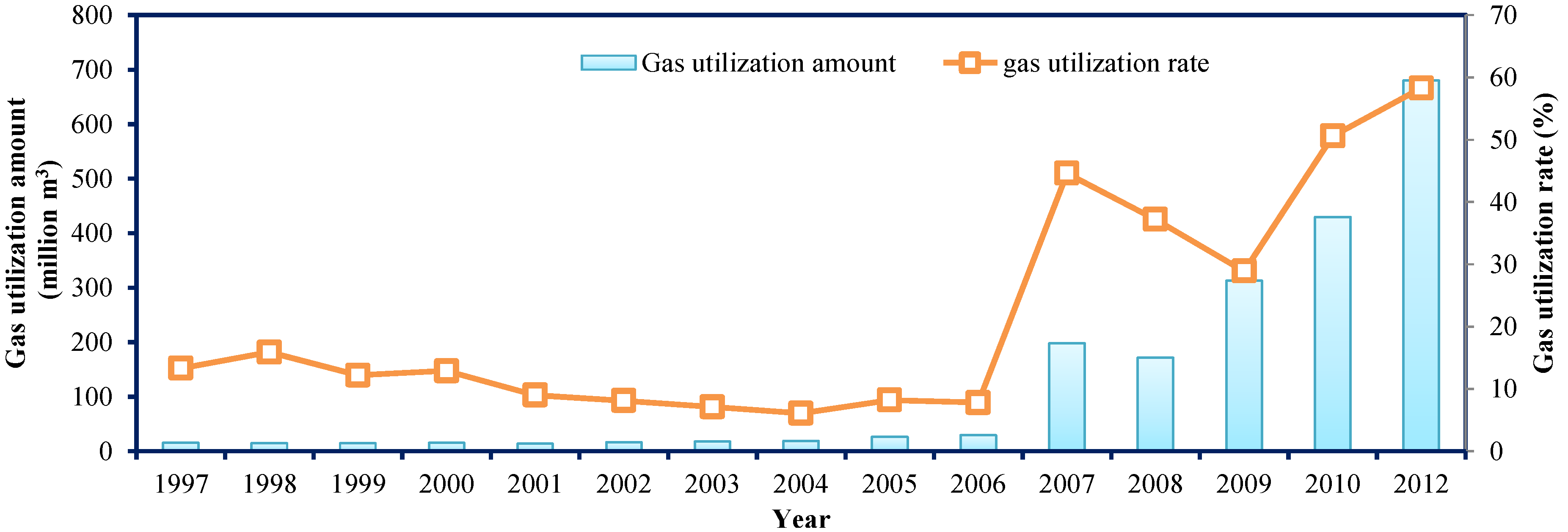
6. Conclusions
- (1)
- On the basis of key strata theory and ground movement concepts, this research found a method of gas release and migration in the overlying strata, analyzed the principle of coal and gas co-extraction in the Yangquan coalfield, and established an implementation method for the co-extraction of coal and CBM in the Yangquan coalfield.
- (2)
- Based on the occurrence characteristics of coal and gas and the mining pressure-relief gas flow law, a technology for the coal and CBM coextraction with the “‘U + I’ type ventilation and high-level gas drainage roadway” as the main technology was developed for the Yangquan coalfield and achieved safe and highly efficient coal and CBM coextraction. The Yangquan coalfield reached a gas drainage amount in the range ~70,000–270,000 m3/day for a single high-level gas drainage roadway, with a capacity of ~35–135 times of a medium CBM surface well (2,000 m3/day) and achieved >90% pressure relief gas drainage rate.
- (3)
- In the Yangquan coalfield, with the development and application of the coal and CBM coextraction technology, the gas drainage effect improved significantly, and the amount of gas drainage increased year after year. In 2013, the pressure-relief gas drainage amount of the Yangquan coalfield reached 1.226 billion m3, improving 78% compared to that in 2009.
- (4)
- A multilevel and diversified gas comprehensive utilization technology system including civil gas, gas heating and cooling, and CMM power generation technologies were developed for the Yangquan coalfield to achieve effective gas resources utilization, exploring new clean energy, promoting the reduction of greenhouse gas emissions and also forming a virtuous cycle of “gas utilization improving gas drainage, and consequently ensuring mining safety”.
Acknowledgments
Author Contributions
Conflicts of Interest
References
- Whittles, D.N.; Lowndes, I.S.; Kingman, S.W.; Yates, C.; Jobling, S. Influence of geotechnical factors on gas flow experienced in a UK longwall coal mine panel. Int. J. Rock Mech. Min Sci. 2006, 43, 369–387. [Google Scholar] [CrossRef]
- Bibler, C.J.; Marshall, J.S.; Pilcher, R.C. Status of worldwide coal mine methane emissions and use. Int. J. Coal Geol. 1998, 35, 283–310. [Google Scholar] [CrossRef]
- Yuan, L. Theory and practice of integrated pillar-less coal production and methane extraction in multi-seam of low permeability. Eng. Sci. 2009, 11, 72–80. [Google Scholar]
- Hu, G.Z.; Wang, H.T.; Fan, X.G.; Hong, S. Mathematical model of coalbed gas flow with Klinkenberg effects in multi-physical fields and its analytic solution. Transp. Porous Media 2009, 76, 407–420. [Google Scholar] [CrossRef]
- Hu, G.Z.; Huang, X.; Xu, J.L.; Wang, H.T. A co-extraction technology of coal and CBM based on the law of gas advanced relieving pressure of in-seam coalface. Disaster Adv. 2012, 5, 867–872. [Google Scholar]
- Saghafi, A. Greenhouse gas emissions from shallow uncovered coal seams. Int. J. Min. Sci. Technol. 2014, 24, 341–344. [Google Scholar]
- Zhou, F.D.; Hou, W.W.; Allinson, G.; Wu, J.G.; Wang, J.Z.; Cinar, Y. A feasibility study of ECBM recovery and CO2 storage for a producing CBM field in Southeast Qinshui Basin, China. Int. J. Greenh. Gas Control 2013, 19, 26–40. [Google Scholar] [CrossRef]
- Connell, L.D.; Pan, Z.; Camilleri, M.; Meng, S.Z.; Down, D.; Carras, J.; Zhang, W.Z.; Fu, X.K.; Guo, B.G.; Briggs, C.; et al. Description of a CO2 enhanced coal bed methane field trial using a multi-lateral horizontal well. Int. J. Greenh. Gas Control 2014, 26, 204–219. [Google Scholar] [CrossRef]
- Huang, Y.P.; Zheng, Q.P.; Neng, F.; Aminian, K. Optimal scheduling for enhanced coal bed methane production through CO2 injection. Appl. Energy 2014, 113, 1475–1483. [Google Scholar] [CrossRef]
- Huang, Y.P.; Rebennack, S.; Zheng, Q.P. Techno-economic analysis and optimization models for carbon capture and storage: A survey. Energy Syst. 2013, 4, 315–353. [Google Scholar] [CrossRef]
- Sun, M.Y. CBM, a nascent new energy. Sci. Technol. Rev. 1996, 8, 59–61. [Google Scholar]
- Perera, M.S.A.; Ranjith, P.G.; Choi, S.K.; Bouazza, A.; Kodikara, J.; Airey, D. A review of coal properties pertinent to carbon dioxide sequestration in coal seams: with special reference to Victorian brown coals. Environ. Earth Sci. 2011, 64, 223–235. [Google Scholar] [CrossRef]
- Perera, M.S.A.; Ranjith, P.G.; Choi, S.K.; Airey, D. Numerical simulation of gas flow through porous sandstone and its experimental validation. Fuel 2011, 90, 547–554. [Google Scholar] [CrossRef]
- Perera, M.S.A.; Ranjith, P.G.; Peter, M. Effects of saturation medium and pressure on strength parameters of Latrobe Valley brown coal: Carbon dioxide, water and nitrogen saturations. Energy 2011, 36, 6941–6947. [Google Scholar] [CrossRef]
- Noackr, K. Control of gas emissions in underground coal mines. Int. J. Coal Geol. 1998, 35, 57–82. [Google Scholar] [CrossRef]
- Zhu, Y.Z. Development status of mine coalbed methane utilization in Yangquan mining area. Coal Sci. Technol. 2013, 41, 70–72. [Google Scholar]
- Li, S.G.; Lin, H.F.; Cheng, L.H. Relation between abutment pressure and relieved gas delivery for fully-mechanized top coal caving. Chin. J. Rock Mech. Eng. 2004, 23, 288–291. [Google Scholar]
- Guo, H.; Yuan, L.; Shen, B.T.; Qu, Q.D.; Xue, J.H. Mining-induced strata stress changes, fractures and gas flow dynamics in multi-seam longwall mining. Int. J. Rock Mech. Min. Sci. 2012, 54, 129–139. [Google Scholar] [CrossRef]
- Xu, J.L.; Qian, M.G.; Jin, H.W. Study on “coal and coal-bed methane simultaneous extraction” technique on the basis of strata movement. J. China Coal Soc. 2004, 29, 129–132. [Google Scholar]
- Qian, M.G.; Xu, J.L.; Miao, X.X. Green Technique in Coal Mining. J. China Univ. Min. Technol. 2003, 32, 343–348. [Google Scholar]
- Qian, M.G.; Miao, X.X.; Xu, J.L. Resources and environment harmonics (green) mining and its technological system. J. Min. Saf. Eng. 2006, 23, 1–5. [Google Scholar]
- Qu, Q.D.; Xu, J.L.; Qian, M.G. Study on influences of key strata movement on gas emissions of next layers. Chin. J. Rock Mech. Eng. 2007, 26, 1478–1484. [Google Scholar]
- Qian, M.G.; Xu, J.L. Study on the “O-shape” circle distribution characteristics of mining-induced fractures in the overlaying strata. J. China Coal Soc. 1998, 23, 466–469. [Google Scholar]
- You, H.; Li, B.Y.; Zhang, F.X. The Complex Control Technology of Gas on Fully-Mechanized Top Coal Caving Work Face in the Yangquan Coalfield; China Coal Industry Publishing House: Beijing, China, 2008. (In Chinese) [Google Scholar]
- Antonette, K.M. Coalbed methane resource potential and current prospects in Pennsylvania. Int. J. Coal Geol. 1998, 38, 137–159. [Google Scholar]
- Romeo, M.F. Coalbed methane: From hazard to resource. Int. J. Coal Geol. 1998, 35, 3–26. [Google Scholar]
- Wu, R.L.; Xu, J.L.; Kong, X.; Shi, C.T.; Luo, B.L.; Hu, Y.M.; Li, Y.K. Gas Pressure Relief Rule of Overlying Coal Seam Induced by Fully Mechanized Top Coal Caving in Long Working Face. J. Min. Saf. Eng. 2010, 27, 8–12. [Google Scholar]
- Wu, R.L.; Xu, J.L.; Hu, G.Z.; Li, Y.C. The technique of coal and gas simultaneous extraction in coal seam group with low permeability and its case studies. J. Mines Met. Fuels 2011, 59, 349–354. [Google Scholar]
- Qin, W.; Xu, J.L.; Hu, G.Z. A method for estimating abandoned gob methane reserves based on the “Three-Zone” theory of relieved gas delivery in coal seams. Energy Sources Part A Recovery Util. Environ Eff. 2013, 35, 585–593. [Google Scholar] [CrossRef]
© 2015 by the authors; licensee MDPI, Basel, Switzerland. This article is an open access article distributed under the terms and conditions of the Creative Commons Attribution license (http://creativecommons.org/licenses/by/4.0/).
Share and Cite
Hu, G.; Xu, J.; Zhang, F.; Zhao, C.; Qin, W.; Zhu, Y. Coal and Coalbed Methane Co-Extraction Technology Based on the Ground Movement in the Yangquan Coalfield, China. Energies 2015, 8, 6881-6897. https://doi.org/10.3390/en8076881
Hu G, Xu J, Zhang F, Zhao C, Qin W, Zhu Y. Coal and Coalbed Methane Co-Extraction Technology Based on the Ground Movement in the Yangquan Coalfield, China. Energies. 2015; 8(7):6881-6897. https://doi.org/10.3390/en8076881
Chicago/Turabian StyleHu, Guozhong, Jialin Xu, Fuxi Zhang, Changchun Zhao, Wei Qin, and Yiran Zhu. 2015. "Coal and Coalbed Methane Co-Extraction Technology Based on the Ground Movement in the Yangquan Coalfield, China" Energies 8, no. 7: 6881-6897. https://doi.org/10.3390/en8076881




